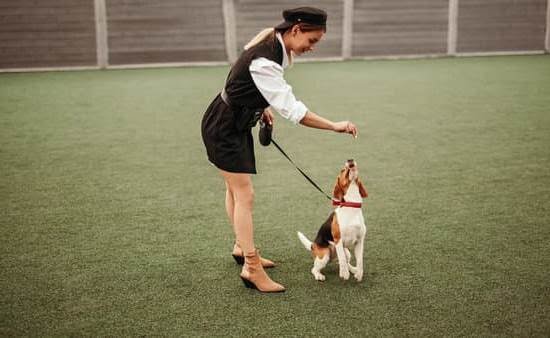Introduction
Teaching dogs to use talking buttons can be a great way to help them communicate their needs and feelings. Talking buttons are special devices that allow the user to select pre-recorded words or phrases with a single press. With just one press, the talking button user is able to communicate with ease. This eliminates the need for barking or whining, which can be often misunderstood by humans.
Furthermore, talking buttons also provide physical and emotional benefits to our four-legged companions. Training a dog to use a talking button gives them an outlet to express themselves, which can reduce stress levels or other behaviors born from frustration and general boredom due to not being able to communicate with us in our language. Additionally, teaching dogs commands via talking buttons will improve their ability to listen and obey what is being said, ultimately making the learning process much easier for both of you!
The training process for these devices is relatively simple and will involve repetition until your pup can recognize which words are associated with each button press. It may take some time before a pet is able to accurately press the correct buttons when commanded, but with patience and practice, your pup should have no problem learning over time. The key is finding out what works best for your canine friend – whether it’s using praise or rewards after successfully completing an action (eg pressing the right button). With this in mind, here’s how you can train your buddy:
Pre-Training Requirements
Essential supplies:
In order to train dogs to use talking buttons, some essential supplies are needed. This includes a talking button and a remote control device or an app (such as Clicker) that will help in the training process. Treats can also be used during the training process to allow your dog to associate desirable behaviour with treats. Additionally, it is a good idea to have a comfortable mat or other comfortable space for your dog to rest while they learn how to use their new tool.
Knowledge:
Another important requirement for training dogs to use talking buttons is knowledge in how exactly to do so. It may be beneficial to do some research on the topic before attempting it, as there are various methods out there and it is important that the best one is chosen. An understanding of the psychology behind canine learning and communication should also be considered and studied before training begins. Knowing what motivates your particular pup and what strategies work best for them should always remain at the forefront of any type of dog training session.
Training Basics
Introduction: Before you begin training your dog to use talking buttons, sit down with them and introduce them to the concept. Start slowly, just talking about what the clicker or talking button is and its purpose. Show them how it works and talk through each step so they understand what’s expected of them. Let your dog explore the button on their own terms so they become comfortable with it before you move on to the next training step.
Stimulus Control: Once your pup has a basic understanding of the button, it’s time to start working on stimulus control or controlling your pet’s response to stimuli such as sounds, actions and objects. Start by showing them how pressing the button will result in a reward. Each time they press the button correctly, praise them, give them treats and continue practicing until they associate pressing the button with rewards – this is known as stimulus control training.
Practicing with Click and Treat Method: After establishing stimulus control, practice using the click and treat method when teaching your pet commands including simple ones like come or sit. Again, start off slow by simply clicking for every desirable behavior your pup exhibits (like obedience) and immediately treating after each successful attempt. As time passes and your pup becomes more comfortable around the talking buttons, increase difficultly in exercises while rewarding successes along the way.
Putting It All Together
Step 1: Choose a managed environment in which to train your dog. A quiet room with few distractions would be ideal, as it will help focus your dog’s attention and maximize learning.
Step 2: Familiarize your dog with the talking buttons device by introducing it to them in a positive, encouraging way – say by doing some simple obedience exercises or offering treats. Show them how the device works (depress the button and wait for the sound/response). Make sure to keep the introduction short and fun so that they don’t become overwhelmed.
Step 3: Begin teaching basic cues such as “go” or “press” so that when your dog hears those words they know that you would like them to depress one of the buttons of the device. Give verbal commands first, followed by physical demonstrations of pressing the button on your own if needed for clarity.
Step 4: As soon as your dog begins responding to verbal cues without any physical prompting, provide rewards for their successes – this could me verbal compliments, petting, or treats depending on what motivates them most!
Step 5: Keep expanding on their knowledge base using different sounds from the button device. For example gradually increase hints of complexity such as requiring your dog to press a specific button instead of just any one at random in response to a given command. This can help promote further learning and prepare them for more complicated tasks down the line.
Step 6: Finally ensure that you thoroughly test out any learned behaviors before rewarding or moving on with training – this can help minimize potential errors and pitfalls while also helping settle any confusion among commands or buttons being used.
Reinforcing Good Behaviors
A great way to train dogs to use talking buttons is by rewarding them for pressing the button with a treat or showing verbal affection. Using the same reward system each time encourages them to associate the reward with pushing the button. Also, gradually increasing the difficulty of having them press a button more than once helps with their learning process. For example, if you start off having them press one button and they do it successfully, then add in another button they need to push before they receive their reward. Using positive reinforcement techniques like this help dogs learn more quickly and enjoy training sessions while they are at it. Additionally, providing vocal cues like giving a command before expecting them to press the buttons can teach them when and why they should press the talking buttons.
Handling Mistakes
Training your dog to use talking buttons can be an involved process, but following a few simple tips will help make it successful. First and foremost, patience is key when it comes to training dogs. Introduce the button slowly and gradually increase the complexity of each task as your pup masters a level. Does your dog need a refresher every now and then? Don’t forget to reward him for any successes.
One common mistake that owners make during this process is giving too many commands at once or progressing before the pup has mastered a given step. When introducing commands to the dog, keep things simple and introduce them one at a time in order to give your furry friend the best chance of success. Also, present the buttons in familiar environments with plenty of rewards so he remains motivated throughout the training process.
Additionally, avoid making sudden changes during training that could easily confuse your pup; incrementally challenging him or her with new tasks is essential for progress. Finally, be sure to have realistic expectations—each individual dog may have difficulties understanding certain concepts quicker than others do depending on their prior level of experience and intelligence. With patience and consistency, you’ll soon have your pup hoovering up basic commands with ease!
Summarizing Concepts and Troubleshooting
Training dogs to use talking buttons for communication can be a challenging yet rewarding endeavor. The key to success is consistency and repetition in order for the dog to learn the skills and associate the buttons with their desired outcome. Here are some helpful tips about how to properly train your pup:
First, identify a few behaviors that you would like to train the dog to learn. Then introduce the talking button along with verbal commands and instruction. Reward desired behavior with positive reinforcement or treats while repeating commands. Repeat this process multiple times each day until the various responses have been committed to memory.
When trouble-shooting any issues during training, it is important to pay attention to body language. Look out for signs of boredom or anxiety in the dog as these may lead to confusion or refusal of commands. In addition, make sure that both verbal cues and rewards remain consistent throughout training so as not to confuse the animal further by changing methods mid-training session. Finally, set clear boundaries and expectations from the start but remain open-minded when it comes potential outcomes from training sessions as no two animals learn in exactly the same way or in precisely the same amount of time.
Final Thoughts
Practical applications for teaching dogs to use talking buttons could include providing a way for them to communicate their emotions and needs, such as expressing feelings of anxiety or hunger. For example, a dog might press a button that says “I’m scared,” or “I’m hungry.” This would be particularly useful for alerting owners of potentially dangerous situations or illnesses. And for those who have trouble communicating with their dogs, the talking buttons can give them an easy way to connect, allowing them to voice their concerns and desires in the same language that they do.
The uses of talking buttons go beyond simply training dogs. They can be used educationally as well. For instance, they can help introduce children to basic principles of communication and animal behavior by engaging them in a hands-on way. Additionally, these buttons could function as aids in behavior modification programs so that owners can effectively teach animals how to respond to specific cues more reliably.
Future considerations should include addressing any potential ethical concerns surrounding teaching animals technology such as talking buttons before introducing it too broadly to the public. For example, one ethical concern would be whether or not it is appropriate for humans to be controlling the actions or communication of another sentient species. As such further research should be undertaken into the implications of using technologies such as this on animal autonomy before its widespread implementation into society becomes commonplace.
Conclusion
Training your dog to use talking buttons can be an incredibly rewarding experience. It takes plenty of patience, consistency, and positive reinforcement to ensure that your pup feels comfortable and safe when using the button. With consistent training sessions and simple instructions you can have your pup confidently pushing their button in no time! As a parting thought, now that you’ve learned how to train dogs to use talking buttons it may be worthwhile integrating different sounds or editing voice clips for your pet to press the button for their desired items – similar to Alexa. You can also train your pooch on complex commands like giving a paw shake or high five. The possibilities are endless and the rewards worth it!
Resources and References
Training your dog to use talking buttons can be a lengthy process, but with the right approaches and techniques it is possible. Before you begin, do some research into dog behavior and communication; understanding how dogs think and learn will greatly increase the chances of successful training.
Once you’ve acquainted yourself with some of the basics, there are several steps you can take to make the teaching process easier. Start by getting your dog familiarized with both the button itself and its sound; using treats or toys as rewards is helpful here. It’s important to ensure that only pressing down on the button results in a reward, so as not to confuse your pup! If your pup fails to press the button after numerous attempts, consider providing verbal or physical cues, such as waving your hand over the device or clapping near it. Once they understand that the button causes the sound and corresponds with rewards, try to fade out these prompts so it becomes a more independent act from your pup.
When it comes time for actual repetition-of-command style training, decide if this would be best conducted in a series of discrete sessions or longer ones spanning multiple days/weeks. Establishing verbal cues early on helps focus learning sessions when faced with distractions—you may choose an action word like “Press!” for this purpose. With enough practice and motivation (aka rewards) eventually your pup will link up their actions (pressing) with rewards; once that happens you’re well on your way in teaching them to press talk buttons!
Reference materials can help point you in directions towards effective training methods unique to each situation. For example, books like Adrienne Farricelli’s Brain Training for Dogs provides insight into clicker-training models used to teach behaviors safely and efficiently while Humane Society’s How To Train Your Dog: A Definitive Guide covers obedience schooling intended for all kinds of dogs. Online resources such as AKC’s Canine Good Citizen Program offer additional resources built around responsible pet ownership as well as helpful tips covering every kind of task imaginable—including talking buttons! With these tools at hand no fluffy companion should be left behind when it comes time for technological activities—or any other kind for that matter!

Welcome to the blog! I am a professional dog trainer and have been working with dogs for many years. In this blog, I will be discussing various topics related to dog training, including tips, tricks, and advice. I hope you find this information helpful and informative. Thanks for reading!





